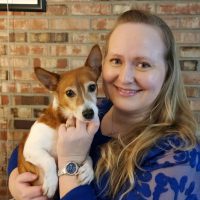Veterinarians are borrowing big to create palatial pet clinics

McDaniel decided she could, tacking on a $750,000 loan to expand her practice by more than two dozen doggy bedrooms, an exam room for specialty procedures and an artificial turf play field. She bought an underwater treadmill for rehab care and had a slushy beverage machine installed as a treat for her 35 employees.
“I dream big, I’ll say that. It seems extreme in some cases,” McDaniel said.
Similar stories can be found across the country as the animal health-care sector experiences stunning growth. Now veterinarians are busting down walls or breaking ground to make room for new clients clamoring for boarding, day care and grooming.
Their balance sheets are getting more complicated, too. In the first nine months of 2022, small-business loans to vet offices spiked 23 percent at PNC Bank, a spokesman said. At Huntington National Bank, vet credit requests have quadrupled in the past four years.
That’s fueled by a surge of pet adoptions, experts say. More than 23 million U.S. households — nearly 1 in 5 — took in a pet during the coronavirus pandemic, according to the American Society for the Prevention of Cruelty to Animals. The share of households with at least one dog jumped from 38 percent in 2016 to 45 percent in 2020, before leveling off last year. Cat ownership went from 25 percent in 2016 to 29 percent in 2022.
For Brian Greenfield and his partners at Animal Clinic Northview, the pandemic pet boom spurred them to accelerate their expansion timeline. The clinic outside of Cleveland added 12,000 square feet of cutting-edge space, including 10 exam rooms, two operating suites, a remodeled intensive care unit, a rehab pool and an underwater treadmill. The project cost $4 million, 75 percent of it in the form of a loan from PNC.
Becka Byrd in San Antonio purchased a plot of land to start a second vet practice in 2018 and opened it in 2021, complete with a “pet retreat and spa.” Boarding suites have flat-screen TVs that display burning fireplaces or play cartoons.
McDaniel’s luxury dog boarding service allows owners to engage with their pets through daily video calls. The clinic’s staff of veterinary technicians and assistants tucks pups into bed each night and gives them nightly treats.
Tommy Monaco in northern New Jersey started his own specialty surgery practice. His wife, Francesca, left her job as a management consultant at ed-tech firm Blackboard to run the business’s finances. Jonathan Trail, in southern New Jersey, added 2,500 square feet of space to his “mom and pop” general vet practice with a $700,000 loan from TD Bank.
“The door stayed open for veterinarians the entire pandemic,” said Brandy Keck, head of veterinary lending at Live Oak Bank. “It became very quickly incredibly evident that the veterinary industry was going to be one of the winners.”
The vet from a ‘pet’s point of view’
Pet expenses, including for health care, are largely considered discretionary. Researchers frequently track consumer expenditures on pet food, toys, training and even surgeries to gauge consumer confidence.
But in the years leading up to the pandemic, loan underwriters began to sense that classification was increasingly unreliable. People no longer view their pets as property, said Ed Nunes, a senior manager at TD Bank who oversees veterinary lending. They see them as family.
There’s also new research that suggests pets were a panacea for many of the stressors associated with isolation, loneliness and poor health habits during the pandemic.
Researchers from the University of Montreal found dog ownership had significant positive health impacts during the pandemic. Owning at least one dog encouraged immunocompromised people to exercise more and sleep better, the researchers found, whereas non-dog owners spent more time sedentary and lost sleep.
Similar dynamics also helped insulate the veterinary industry during the Great Recession; revenue from the vet sector mostly just flattened rather than tanked, Nunes said.
The pandemic accelerated two other dynamics: Not only did people adopt more pets, they got stuck at home together. When humans are more attentive to their animal companions, they spend more money on them, veterinarians say.
That meant more visits — emergency rooms sometimes reported hours-long waits to see patients, and some vet offices said they stopped taking new clients for preventive care appointments — and more spending on nonmedical services.
In other words, said Byrd in San Antonio, we spoiled our pets. And since pets don’t pay for their own care, veterinarians cater their businesses to attract human clients. So boarding facilities start to look like resort hotels, and day-care centers start to look like kindergartens instead of kennels.
“Anthropomorphism is everything,” Byrd said. “I think that’s true even of myself.”
Vets are quick to point out the medical case for some of these amenities. The body of knowledge and scientific advances in animal medicine have been rapid, Greenfield in Ohio said, and vet clinics need to constantly invest to re-equip their facilities.
More and more practices are also taking to a new approach not just to medical treatment but other pet services, known as “Fear Free.” That includes basic protocols for vaccine administration (using food to build trust and for positive reinforcement) and nail trimming (again food, but also sometimes a mild sedative for anxious pets), though each step involves consultation between doctors and pet owners.
There are standards for pet boarding and day care, too. Individual dog enclosures, for example, may have some privacy, like a curtain or blankets where a dog can burrow, according to Fear Free protocols. Cats are well served by placing diffusers with calming pheromones around a facility or playing certain music. Turns out dogs and cats like wildly different tunes.
“We are now looking at, what do our facilities look like from a pet’s point of view?” said Carmen Rustenbeck, CEO of the International Boarding and Pet Services Association. “What does it look like? What does it sound like? What does it smell like? How does it feel on their paws?”
The Fear Free approach has gotten popular enough that Nunes from TD Bank studies it so he can better evaluate the business plans of loan applicants.
“Part of being a specialty lender is being a trusted adviser to the doctor,” he said. “I know an awful lot about practice management.”
And on the medical side, pet parents are increasingly willing to invest more money into treatments to extend the lives of their animals, Greenfield said.
That’s a great thing for pets — “More longevity, healthier, happier, pain-free quality of life,” Greenfield said — but it increases economic pressure in a vet industry that is already facing a shortage of doctors and technicians. It’s setting off an arms race among practitioners to have the nicest facility, or most advanced equipment, or best amenities. And that extends beyond medical care and into day-care centers and boarding.
It’s not cheap for vets to make all these investments. Their business is capital intensive — a new piece of equipment is pricey, and labor costs are high, too. Some practice owners take out loans to have a working line of capital to pay staff, bank officials say.
In many cases, large student loans add to the burden. Four years of vet school costs more than $200,000 on average, according to personal finance site Bankrate, forcing many students to take on debt. And when they graduate, they can expect a median pay of $100,370 per year, according to 2021 federal data.
Even so, the Bureau of Labor Statistics forecasts strong demand for practitioners, with veterinarian jobs climbing 19 percent over the next decade, compared with 3 percent for human doctors and 5 percent for the rest of the U.S. workforce.
Those costs are still generally worth it, however, given how resilient the industry is. “We know that even when times get difficult, [a pet owner] is going to take care of his dog,” said David Burch, a director of specialty banking at Huntington. “And if something bad happens, he’d maybe opt to not take a trip to Disney World so he can care for his dog.”
Defaults on veterinary loans are so uncommon, Huntington doesn’t measure them, Burch said. And so many vets are interested in becoming practice owners that doctors are often willing to acquire struggling practices and take on their financial liabilities. A constant refrain in the industry is that the quickest way to get ahead of student debt is to buy into a practice.
Vet clinics, owners say, just have to keep up with consumers’ expectations.
During Byrd’s practice expansion, she built a separate room for pet acupuncture — good for arthritis treatment, and even nausea and gastrointestinal inflammation, she said — and euthanasia consultations, and an entire wing for pet boarding.
Larger, corporate animal hospitals can feel like an assembly line for surgeries, said Tommy Monaco, who started his own practice in northern New Jersey in November. He thought a smaller surgical practice would be a successful alternative and designed one to maximize animal patient and pet parent comfort.
At his clinic, Greenfield and his ownership partners wanted capacity to treat more animals and didn’t want to have to send clients to other facilities for rehab care or prescriptions. They more than doubled the size of the hospital pharmacy and added a brightly lit exercise room for animals recovering from surgery or with chronic joint and muscle problems.
Across a small partition is a rehab pool where vets can jump in the 97-degree water and splash around with recovering pups — or dogs who just need some low-impact exercise. Up a back staircase, the hospital has two apartments for doctors who need a nap between shifts and a large conference area for training sessions.
When Greenfield recruits new vets — the practice is almost constantly hiring, he said — he shows them the clinic and watches their eyes light up as they walk past an operating observation room, an oversize ICU and a drive-through window, just in case the hospital has to go back to socially distanced care again.
“Quite frankly,” he said, “at the time when we built it, we thought it was a little too big.”






